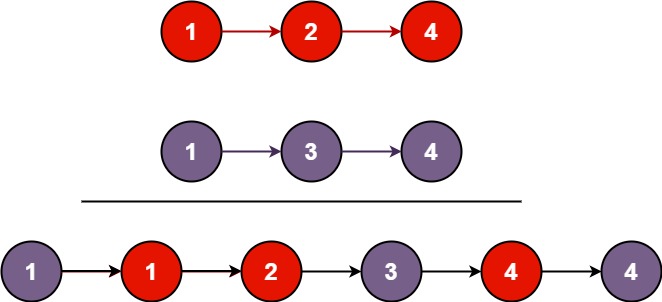You are given the heads of two sorted linked lists list1 and list2.
Merge the two lists in a one sorted list. The list should be made by splicing together the nodes of the first two lists.
Return the head of the merged linked list.
Example 1:

Input: list1 = [1,2,4], list2 = [1,3,4]
Output: [1,1,2,3,4,4]
Example 2:
Input: list1 = [], list2 = []
Output: []
Example 3:
Input: list1 = [], list2 = [0]
Output: [0]
Constraints:
[0, 50].-100 <= Node.val <= 100
list1 and list2 are sorted in non-decreasing order.要把兩個排序過的單向鏈結合成一個單一排序的鏈結串列
直覺的作法就是把每個 l1, l2 的 node 逐步比對
當遇到比較小的值就把值複製到新的結點放到 merged list
每次把 11, 12 比較小的鏈結往後移動
直到 l1 或 l2 走到尾部
如果 其中一個走完,把沒走完直接接到目前 merged list 的最後
時間複雜度 O(m+n)

/**
* Definition for singly-linked list.
* type ListNode struct {
* Val int
* Next *ListNode
* }
*/
func mergeTwoLists(l1 *ListNode, l2 *ListNode) *ListNode {
var merged *ListNode
var cur *ListNode
if l1 == nil && l2 == nil {
return merged
}
if l1 == nil {
return l2
}
if l2 == nil {
return l1
}
for l1 != nil && l2 != nil {
smallest := l2
if l1.Val < l2.Val {
smallest = l1
}
if cur == nil {
cur = smallest
} else {
cur.Next = smallest
}
if smallest == l1 {
l1 = l1.Next
} else {
l2 = l2.Next
}
if merged == nil {
merged = cur
} else {
cur = cur.Next
}
}
if l1 != nil {
cur.Next = l1
} else {
cur.Next = l2
}
return merged
}
